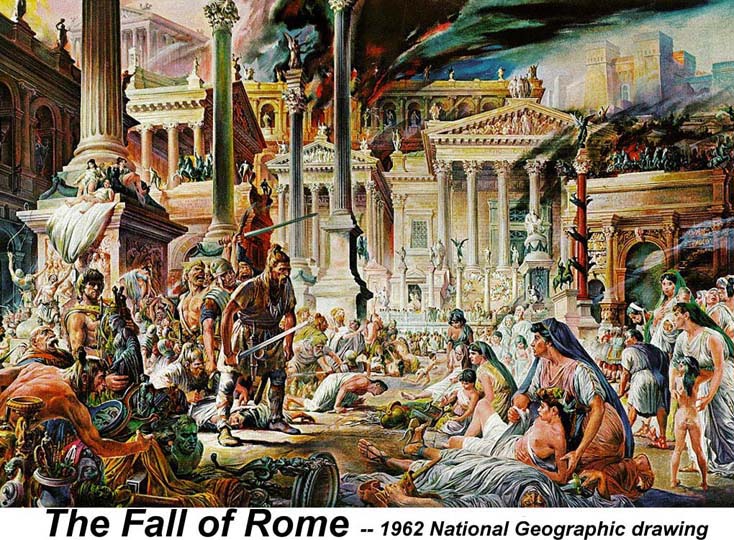Milan,
Ravenna, Constantinople, Avignon, etc.
Before starting on the Medieval period,
we'll go into some background:
Constantine's legacy -- for better or
worse
Barbarians -- anyone non-Roman --
"your barbarian is my cousin"
Benedict and early monasticism
Gregory was a monk and maybe a
Benedictine
He wrote a biography of Benedict
Byzantines and their Representatives.
Despite what it sounds like, this
isn't a linear history course
There are timelines and an
abbreviated history, but we will concentrate on
trends and controlling factors (some
of which are people) rather than on events
We won't always go in chronological
order
Benedict, for example, is in the
century before Gregory but will come after him in the
course.
And the founders of the other
Medieval monastic orders,
Francis and Dominic, will be
discussed with Benedict even though
they're late Medieval. Even
Ignatius, who was counter-Reformation, will rate a
mention.
Krautheimer's Medieval Rome
http://www.mmdtkw.org/VKrautheimerRome.html
B. Constantine's legacy
The "Donation of Constantine"
Constantine gives Rome and the
Empire to Pope Sylvester 1 -- impious fraud
http://www.newadvent.org/cathen/05118a.htm
Extent of the Empire -- map exercise:
from Augustus until 1500
Orphan maps? (Periodical Historical
Atlas of Europe)
http://www.euratlas.com/time1.htm
Structures: Church basilicas and rounds
Tituli -- home churches to which
someone held title
Ancient Roman Basilicas
Basilica of Maxentius/Constantine
Largest built, curile basilica
Tomb dinners -- an ancient
Mediterranean tradition: Dining/assembly area in
front of tombs
Grand
triclinia: banquet halls for large numbers of
guests
Exposing tombs -- ambulatoria
around tombs
Medieval
Churches of Rome
Basilicas:
Old St. Peter's
http://www.mmdtkw.org/VOldStPeters.html
http://rubens.anu.edu.au/htdocs/bycountry/italy/rome/popolo/midjpg/alphabetical/00968.html
Not oldest, but eventually assumed
greatest importance.
Funerary chapel expanded into huge
basilica
Good example of a semi-round
ambulatory cut around a tomb
Perhaps built by Constantine (or
Constantius)
Eventually demolished because it
would have fallen -- but lasted more than 1000 yrs.
St. John Lateran
http://roma.katolsk.no/giovannilaterano.htm
http://www.canticanova.com/articles/misc/art7f1.htm
http://rubens.anu.edu.au/htdocs/bycountry/italy/rome/popolo/midjpg/alphabetical/00386.html
http://members.tripod.com/romeartlover/Vasi46.html
"Mother of all churches"
Converted grand tricliniun
Not a tomb church
Medieval Baptistery still standing
"Constantine's bathtub" (Rienzo
connection)
Medieval cloister
Scala Sancta
Leo 3's Triclinium Mosaic from Palace
Disastrous Palace fires
Renaissance/baroque redecoration of
the church
Quattro Coronati
http://www.santiquattrocoronati.org/index_enn.htm
http://www2.siba.fi/~kkoskim/rooma/pages/SQUATTRO.HTM
http://rubens.anu.edu.au/htdocs/bycountry/italy/rome/popolo/database/new/01416.html
4th Century Titulus Aemilianae built
by Pope Miltiades (311-14)
Restored by Pope Honorius 625-638)
and by Pope Hadrian 772-95
Basilica built by Pope Leo 4
(847-55).
Sacked by the Norman, Robert
Guiscard, in 1048.
Rebuilt on a smaller scale by Pope
Paschal 2 (1099-1118).
Monastery and cloister added in the
12th and 13th centuries, held by Benedictines until the
16th.
Fortress guarding the Lateran (1246,
Innocent 4) and haven for Popes during conflict with the
Hohehstaufen
Camaldolese monks got it in 1521 and
40 years later the Augustinians got it.
Now Augustinian nuns.
Fresco finds in late 1990's
St. Sabina
http://rubens.anu.edu.au/htdocs/bycountry/italy/rome/popolo/midjpg/alphabetical/01071.html
5th century (422-23), built on the site of Titulus Sabinae
by Peter the Illyrian.
Became the Dominican HQ in 1218
(overtaken by S. Maria Sopra Minerva in 1370.)
Last home of Dominic, later was home
of Thomas Aquinas.
Wooden doors are pre-450, perhaps the
first doors of the church.
Windows are translucent selenite.
Restored in first half of 20th
century -- renaissance and baroque additions removed.
Medieval cloister is attached.
Additional courtyard with "Dominic's"
orange tree.
Rare Round Churches
Round Roman Temple
Funerary rotundae without fronting
basilicae?
S. Costanza
https://en.wikipedia.org/wiki/Santa_Costanza
Originally a Mausoleum located outside
the Aurelian walls on Via Nomentana
Not a church until 1254 -- Pope
Alexander 4
Vault mosaic, with portrait of
Costanza, is 4th century
Costanza's porphyry sarcophagus --
original in the Vatican
S. Maria ad Martyres -- Pantheon
https://en.wikipedia.org/wiki/Pantheon,_Rome
http://www.romanconcrete.com
Built by Hadrian as a massive rebuilding
of Marcus Agrippa's homage to the Julio-Claudian patron
gods.
Temple closed in 5th century and
given by Emperor Phocas to Pope Boniface 4.
Boniface consecrated it as S. Maria
ad Martyres before 609
(in that year he proclaimed "All
Saints Day" in the church.)
In 663, Eastern Emperor Constans 2
stole the bronze roof tiles.
Gregory 3 reclad the roof with lead
in 735.
Used as a fortress and later as a
poultry market during Avignon Captivity (1309-77)
Restored to use as a church after the
Captivity -- in use since then.
Renaisance redecorations.
S. Stefano Rotondo al Celio
https://en.wikipedia.org/wiki/Santo_Stefano_al_Monte_Celio
http://rubens.anu.edu.au/htdocs/bycountry/italy/rome/popolo/database/new/01454.html
and following pages
A purpose built round church --
probably modeled directly after the Byzantine church of
the Holy Sepulchre in Jerusalem. Same size as the
Jerusalem Holy Sepulchre rotunda.
First church consecrated by Pope
Simplicius (468-83), perhaps in 460.
Perhaps financed by the Verlarian
family who had Jerusalem connections -- not a titulus.
Built on the site of a Mithraeum
within the Castra Peregrinorum (a military barracks for
foreign troops -- training for foreign officers).
Decorated by Pope John 1 (523-26) and
Pope Felix 4 (526-30).
Colonnades altered and transverse
arches added by Innocent 2 (1130-1143).
Renaissance restorations
Martyr frescoes
Other Medieval Churches
S. Sebastiano -- 3rd century catacomb
church, 4th basilica, 9th rededication
https://en.wikipedia.org/wiki/San_Sebastiano_fuori_le_mura
Ss. Giovanno e Paulo -- 2-3 century
titulus, 4th century church, restored mid-5th, restored
early 12th after Norman sacking
https://en.wikipedia.org/wiki/Basilica_of_Saints_John_and_Paul_on_the_Caelian_Hill
S. Pudenza (Pudenziana) 390 --
original but badly restored apse mosaic is the earliest
of its type in Rome
https://en.wikipedia.org/wiki/Santa_Pudenziana
S. Maria Maggiore
https://en.wikipedia.org/wiki/Basilica_di_Santa_Maria_Maggiore
Basilica Liberiana 352-66, Damasus Basilica 366-84,
Sixtus3432-40
S. Maria della Neve -- Aug 4-5 358
http://www.italyheritage.com/traditions/august/05-madonna-della-neve.htm
Ss. Cosmas and Damian in Foro 527
https://en.wikipedia.org/wiki/Santi_Cosma_e_Damiano
S. Marco in Piazza Venezia -- ca 800
https://en.wikipedia.org/wiki/San_Marco_Evangelista_al_Campidoglio,_Rome
http://www.romeartlover.it/Vasi39.htm
S. Cecilia in Trastevere -- early
titulus Ceacilia, 5th century church replaced in 9th
https://en.wikipedia.org/wiki/Santa_Cecilia_in_Trastevere
http://www.sacred-destinations.com/italy/rome-santa-cecilia
S. Prassede (Praxedes, sister of
Pudenza) 5th century church replaced in 822
https://en.wikipedia.org/wiki/Santa_Prassede
